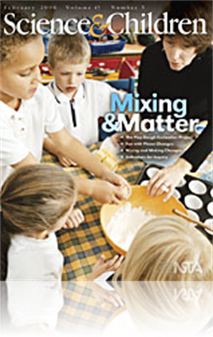All Science and Children resources
Journal Article
Science 101: Why does a color change indicate a chemical change?
There are a a number of indicators you can use to determine whether or not a chemical reaction has occurred. Among them are a change in color, the evolution of a gas, and the production or absorption of heat. To understand why any of these indicato...
Journal Article
Preschool children explore matter and complete a solution-making lesson in which they categorize substances (water, sugar, and lemon juice) and mix them together to make a change (lemonade)....
Journal Article
Working with young children and chemicals requires attention to safety. This article details the experiences of a third-grade teacher who used a “disaster” to create a hands-on inquiry that introduces children to chemistry safety during a third-g...
Journal Article
The Play Dough Evaluation Project
Fourth-grade students gain a deeper understanding of the meaning of “properties” by evaluating and comparing play doughs. Students also hone their observation and reporting skills and enrich their vocabulary, integrating language arts into this a...
Journal Article
Simple phase change explorations build a “solid” foundation for later learning about molecules. Using water as the example, upper-elementary students participate in activities that introduce the idea of the arrangement of molecules in a solid, li...
Journal Article
Fifth-grade students use homemade plant-based acid/base indicators to learn about matter at an age-appropriate level and develop process skills. As a result of completing this lesson sequence the students should be able to perform many tasks using pr...



